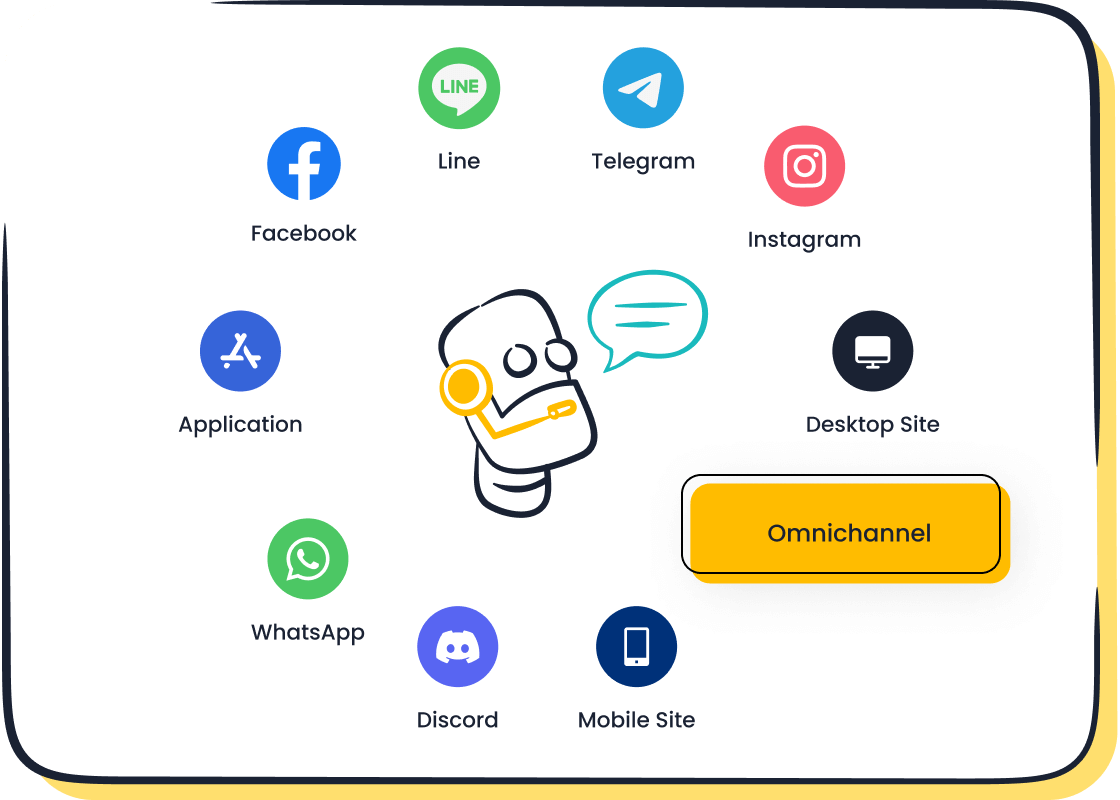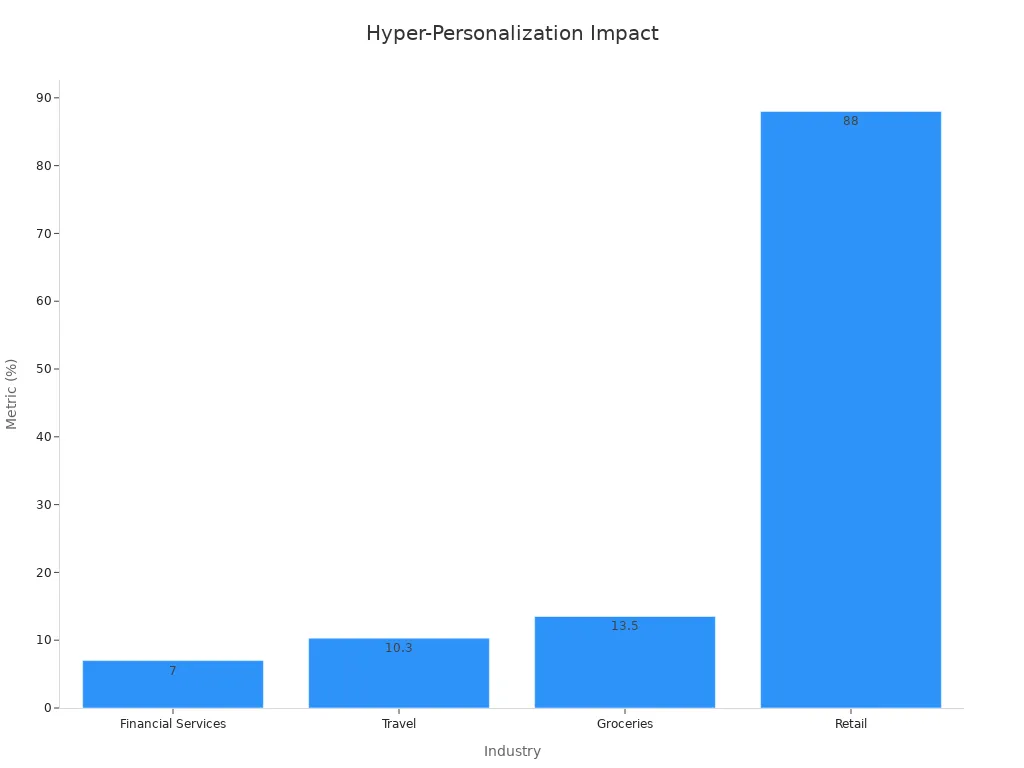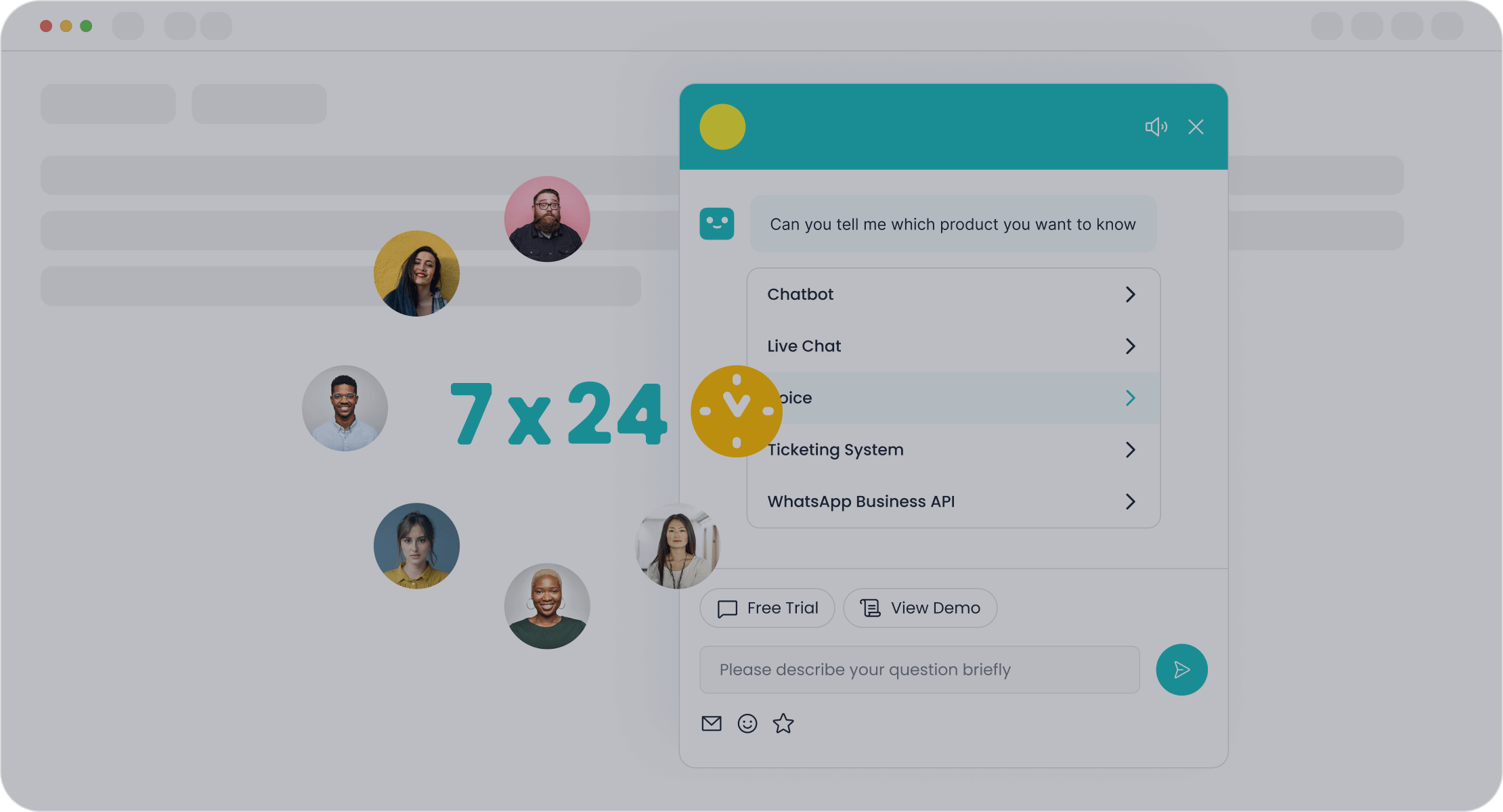AI Trends Redefining Omnichannel Chatbots for Enhanced CX

AI is reshaping how you interact with businesses, especially through omnichannel chatbots. These intelligent tools automate repetitive tasks, provide instant replies, and personalize experiences to meet your specific needs. By 2025, AI-powered chatbots will handle 95% of customer interactions, saving billions of hours annually. Companies like Sobot are leading this transformation, ensuring faster responses, seamless communication across platforms, and improved customer satisfaction. With AI's ability to analyze data and anticipate your needs, the future of customer service is set to become faster, smarter, and more connected than ever.
Hyper-Personalization: The Future of Omnichannel Chatbots

Understanding Customer Intent with AI
Understanding what your customers want is the cornerstone of delivering exceptional service. AI-powered chatbots excel at this by analyzing vast amounts of data to predict customer intent. These systems use advanced algorithms to process inputs like browsing behavior, purchase history, and even sentiment from social media. For example, sentiment scores derived from platforms like Twitter or Facebook can reveal how customers feel about your brand across different market segments. This insight allows you to tailor your responses and offerings more effectively.
Metrics such as accuracy, precision, and recall further validate the performance of AI in understanding intent. For instance, a high F1 score ensures that the chatbot identifies relevant customer needs, even in complex scenarios. Faster response times also enhance user experience, while increased session durations reflect higher engagement levels. By leveraging these capabilities, you can create a seamless and satisfying interaction for your customers.
Predictive Analytics for Anticipating Needs
Predictive analytics takes customer understanding to the next level by forecasting future behaviors. By analyzing historical data, this technology identifies patterns that help you anticipate what your customers might need next. For instance, in retail, predictive models can suggest products based on past purchases, reducing cart abandonment rates and boosting sales. In financial services, these models have led to a 7% increase in credit card applications, showcasing their effectiveness in driving customer engagement.
This approach relies on mathematical algorithms and statistical models to make informed decisions. By mining data and analyzing customer behaviors, businesses can craft marketing strategies that resonate with their audience. Imagine a travel company using predictive analytics to offer personalized vacation packages, resulting in a 10.3% increase in add-to-cart rates. Such insights not only enhance customer experience but also improve your bottom line.

Dynamic Personalization Across Channels with Sobot Chatbot
Dynamic personalization ensures that your customers receive tailored experiences across all touchpoints. The Sobot Chatbot stands out in this area by leveraging AI-driven personalization to adapt to customer preferences in real time. For example, it analyzes browsing and purchase history to recommend products that align with individual tastes. This capability not only improves customer satisfaction but also increases the likelihood of repeat purchases.
Sobot's omnichannel chatbot integrates seamlessly across platforms like WhatsApp, email, and SMS, ensuring consistent communication. Whether a customer interacts via live chat or voice, the chatbot delivers personalized responses that feel human-like. This approach has proven effective in industries like e-commerce, where personalized recommendations significantly boost profitability. By adopting such solutions, you can enhance customer loyalty and drive long-term growth.

| Case Study | Metric | Impact |
|---|---|---|
| Spotify | Custom playlists based on listening habits | Increased customer satisfaction and loyalty |
| Starbucks | Personalized offers based on purchase history | Enhanced customer loyalty |
| Netflix | Personalized recommendations based on viewing history | Improved customer retention |
| Amazon | Personalized suggestions and incentives | Increased customer advocacy |
| Sephora | Personalized beauty tips and product recommendations | Boosted customer profitability |
Dynamic personalization, as demonstrated by Sobot Chatbot, is not just a trend but a necessity in today’s competitive landscape. By implementing such solutions, you can meet customer expectations while optimizing operational efficiency.
Generative AI: Revolutionizing Chatbot Conversations
Human-Like Interactions Through Generative AI
Generative AI has transformed chatbots into conversational tools that mimic human communication. These systems use advanced natural language processing (NLP) to understand context and generate responses that feel natural. Unlike traditional chatbots, generative AI-powered conversational AI can engage in open-ended dialogue, making interactions more dynamic and engaging. For example, ChatGPT, which reached over 100 million users within eight months of its launch, showcases the potential of generative AI in creating meaningful conversations.
Statistical models like GPT (Generative Pre-trained Transformer) enable chatbots to improve customer support systems by delivering responses that closely resemble human communication. This approach enhances user experience and builds trust. Businesses using generative AI chatbots report faster response times and higher customer satisfaction rates. Sobot’s AI-driven chatbots leverage these capabilities to provide seamless, human-like interactions across multiple channels, ensuring your customers feel valued and understood.
Multilingual Support for Global CX
Generative AI empowers chatbots to break language barriers, making them indispensable for businesses with a global presence. AI chatbots provide instant assistance in multiple languages, ensuring consistent support for customers worldwide. This capability is vital for industries like retail and e-commerce, where customer interactions span diverse regions and languages.
Sobot’s conversational AI excels in multilingual support, offering real-time translations and localized responses. Whether your customers speak English, Spanish, or Mandarin, Sobot’s chatbot ensures they receive accurate and culturally relevant replies. This feature enhances customer satisfaction and loyalty, especially for international brands. By adopting multilingual chatbots, you can expand your reach and deliver exceptional customer experiences across borders.
Real-World Applications in Customer Support
Generative AI has revolutionized customer support systems by automating complex tasks and improving efficiency. Businesses using AI chatbots report significant improvements in key metrics. For instance:
| Metric | Improvement/Result |
|---|---|
| Customer Satisfaction | 9.44% increase |
| Support Team Productivity | 13% increase |
| Escalation Rate | Below 2% |
| SLA Compliance | 40% higher |
| Response Time | Instant replies |
| Query Resolution | 44% automated |
| Availability | 24/7 service |
| Ticket Processing Speed | Up to 80% faster |
| Resolution Rate | 68% increase |
| Team Efficiency | 80% increase |
Sobot’s AI chatbot integrates seamlessly into customer support systems, automating query resolution and providing instant replies. Its 24/7 availability ensures your customers receive timely assistance, even during peak hours. For example, Opay, a financial service platform, achieved a 90% customer satisfaction rate and reduced operational costs by 20% after implementing Sobot’s omnichannel solution. These results highlight the transformative impact of generative AI on customer support.
Real-Time Decision-Making for Seamless Customer Journeys
Context Awareness in Omnichannel Chatbots
Context awareness enables chatbots to understand and respond to customer queries accurately. By analyzing past interactions, preferences, and real-time inputs, these systems deliver personalized and relevant responses. For example, if a customer asks about a product they viewed earlier, the chatbot can instantly provide details without requiring additional input. This capability reduces frustration and enhances satisfaction.
Key performance indicators highlight the effectiveness of context-aware chatbots:
| Performance Indicator | Description |
|---|---|
| Containment Rate | The percentage of conversations fully handled by the chatbot without human intervention. |
| First Contact Resolution (FCR) Rate | The chatbot’s ability to resolve user issues during the first interaction. |
| Error/Confusion Rate | The frequency with which the chatbot fails to understand queries or provides irrelevant answers. |
| Customer Satisfaction (CSAT) Score | Direct user feedback regarding satisfaction with the chatbot experience. |
Metrics like response time and resolution rate also play a crucial role. Faster replies and higher resolution rates ensure your customers receive efficient and accurate service, boosting their overall experience.
Proactive Support with Real-Time Data
Real-time data empowers chatbots to anticipate customer needs and offer proactive support. By analyzing behavioral patterns, transactional data, and web analytics, businesses can identify pain points and deliver timely solutions. For instance:
- Web analytics tools track page views, sessions, and bounce rates, helping you understand customer navigation.
- Transactional data reveals spending habits, enabling personalized marketing strategies.
- Behavioral data shows how customers interact with products, allowing you to prioritize improvements.
Imagine a chatbot that notices a customer struggling to complete a purchase. It can proactively offer assistance, such as suggesting payment options or providing a discount code. This approach not only resolves issues but also builds trust and loyalty.
Adaptive Responses to Enhance CX
Adaptive responses ensure chatbots adjust their replies based on customer feedback and evolving needs. These systems use AI to analyze satisfaction scores, effort levels, and loyalty indicators like CSAT, CES, and NPS.
- CSAT measures how well customer expectations are met.
- CES evaluates the ease of interactions.
- NPS gauges loyalty and the likelihood of recommendations.
Transforming feedback into actionable insights leads to significant improvements in customer satisfaction. For example, if customers frequently mention delays in response times, the chatbot can prioritize faster replies. Adaptive responses create a dynamic and engaging experience, ensuring your customers feel valued and understood.
Voice Technology: The Rise of Conversational AI

Voice-Enabled Omnichannel Chatbots
Voice technology is revolutionizing how you interact with businesses. Voice-enabled omnichannel chatbots allow you to communicate naturally, using spoken language instead of typing. These chatbots leverage advanced speech recognition to understand your queries and provide instant responses. For example, when you call a customer service hotline, a voice-enabled chatbot can guide you through options, answer questions, or even complete transactions.
Voice analytics enhance customer service outcomes by capturing real-time sentiment and resolving issues immediately. Businesses gain deeper insights into your preferences by analyzing speech patterns. This data helps them tailor responses and improve satisfaction.
| Evidence Type | Description |
|---|---|
| Real-time sentiment analysis | Voice analytics captures customer sentiment in real-time, enabling businesses to swiftly address concerns and improve satisfaction. |
| Immediate issue resolution | By analyzing conversations as they happen, agents can quickly identify and resolve issues, preventing escalations. |
| Deeper customer insights | Agents gain insights into customer needs and preferences through speech pattern analysis, allowing for tailored responses. |
Voice-enabled chatbots create seamless experiences across platforms like WhatsApp, email, and phone calls. They ensure you receive consistent and efficient service, regardless of the channel you choose.
Accessibility and Inclusivity Through Voice AI
Voice AI makes customer service more accessible and inclusive. It empowers individuals with disabilities, such as visual impairments, to interact with businesses effortlessly. You can simply speak your query, and the chatbot will respond with clarity. This technology also bridges language gaps, offering multilingual support for global audiences.
Imagine a scenario where you need assistance in a language other than English. Voice AI can instantly translate your query and provide a response in your preferred language. Sobot’s voice-powered solutions excel in this area, ensuring accurate translations and culturally relevant replies. This inclusivity fosters trust and loyalty, especially for international brands striving to connect with diverse audiences.
Sobot's Role in Voice-Powered Customer Service
Sobot’s voice-powered solutions redefine customer service by combining advanced AI with omnichannel capabilities. Its platform reduces inbound discussion volume by 20%, allowing agents to focus on complex issues. Over 80% of queries receive correct answers from Sobot’s AI, ensuring you get accurate and timely support.
| Metric | Result |
|---|---|
| Reduction in inbound discussion volume | 20% |
| Increase in positive feedback | 96% + |
| Correct answers from AI platform | Over 80% |
| Customer satisfaction rate | Over 95% |
| Self-service question resolution | 22.2% |
| Customer satisfaction score (CSAT) | 97% |
| Problem resolution rate | 85% |
| Customer happiness rate | 99% |
| Sign-off rate increase | About 35% |
| COD collection rate increase | About 40% |
Sobot’s voice AI ensures 24/7 availability, enabling you to resolve issues anytime. Its solutions improve customer satisfaction rates to over 95%, demonstrating their effectiveness in delivering exceptional service. Whether you need assistance with a product or want to track an order, Sobot’s voice-powered chatbots provide reliable and efficient support.
Ethical AI Practices: Building Trust in Omnichannel Chatbots
Addressing Bias and Ensuring Fairness
Bias in AI systems can lead to unfair outcomes, especially in ai customer service. You can address this issue by adopting tools and practices that ensure fairness. For instance:
- The What-If Tool by Google helps you explore misclassifications and decision boundaries in AI models.
- Facebook’s Fairness Flow alerts developers to biases related to race, gender, or age.
- Model Cards, introduced by Google, provide transparency about algorithms, detailing their strengths and weaknesses.
- Regular algorithm audits identify and correct biases, ensuring fair decision-making processes.
By implementing these measures, you can build trust with your customers and ensure your AI systems deliver equitable outcomes. Sobot integrates fairness principles into its AI solutions, ensuring unbiased and reliable customer interactions across all channels.
Data Privacy and Security in AI Systems
Protecting customer data is crucial in ai customer service. Regulations like GDPR and CCPA set high standards for data handling, requiring explicit consent and transparent practices. You can enhance data security by adopting Privacy by Design principles, which incorporate privacy measures from the start of AI system development.
Sobot ensures compliance with these regulations by implementing robust governance frameworks. Its AI systems use encrypted backups and data anonymization to safeguard customer information. These practices not only protect your customers but also enhance their trust in your brand.
Sustainable AI for Energy Efficiency
Sustainable AI practices reduce environmental impact while improving operational efficiency. Metrics supporting these practices include:
| Metric Type | Description |
|---|---|
| Model Optimization Techniques | Methods that enhance the energy efficiency of AI models, reducing their overall energy consumption. |
| Energy-Efficient Hardware | Use of alternatives like TPUs and FPGAs that consume less power compared to traditional hardware. |
| Energy-Efficient Data Centers | Strategies for designing data centers that minimize energy use and utilize renewable energy sources. |
Sobot employs energy-efficient hardware and optimized AI models to lower energy consumption. Its commitment to sustainability ensures that your ai customer service operations remain eco-friendly while delivering exceptional results.
The future of customer interactions is being redefined by AI trends that enhance customer experience across industries. Predictive analytics enables brands to anticipate needs, while hyper-personalization tailors experiences in real time. For example, a real estate portal used chatbots to handle millions of inquiries, improving satisfaction and reducing agent workload. In hospitality, AI chatbots cut guest request resolution times by 50%, allowing staff to focus on complex tasks.
Sobot leads this transformation with its AI-powered solutions, offering tools like multilingual chatbots and voice-enabled systems. These innovations ensure seamless communication and personalized support, helping businesses stay competitive. By adopting AI-driven technologies, you can elevate customer satisfaction, streamline operations, and prepare for the future of customer interactions.
Tip: Embracing AI today ensures your business thrives in tomorrow’s customer-centric landscape.
FAQ
What is an omnichannel chatbot, and how does it improve customer engagement?
An omnichannel chatbot interacts with customers across multiple platforms like email, WhatsApp, and social media. It ensures seamless communication by maintaining context across channels. This improves customer engagement by providing consistent and personalized experiences, making interactions more efficient and satisfying.
How does enhanced personalization benefit customers in ecommerce?
Enhanced personalization tailors recommendations, messages, and support to individual preferences. In ecommerce, this means customers see products they are likely to buy, receive relevant offers, and enjoy faster issue resolution. This creates a more satisfying shopping experience and increases customer loyalty.
Can chatbots handle complex customer queries?
Yes, modern chatbots use advanced AI to understand context and intent. They can resolve complex queries by analyzing customer data and providing accurate responses. For unresolved issues, chatbots seamlessly transfer the conversation to human agents, ensuring a smooth customer experience.
How does chatbot integration support omnichannel experiences?
Chatbot integration connects various communication platforms into one system. This ensures customers receive consistent support, whether they contact you via chat, email, or voice. It simplifies customer interactions and enhances customer-centric experiences by maintaining context across channels.
Why is omnichannel integration important for businesses?
Omnichannel integration ensures all customer touchpoints work together. It allows businesses to deliver personalized experiences and maintain consistent communication. This improves customer satisfaction and builds trust, especially in industries like ecommerce, where seamless interactions are crucial.
See Also
Enhancing Customer Satisfaction Through Chatbots In E-commerce
Comprehensive Overview Of Omnichannel Call Center Solutions
Ten Essential Steps For Implementing Omnichannel Contact Centers
Key Advantages Of Integrating Chatbots Into Websites
Increasing Sales With E-commerce Live Chat Software Solutions
